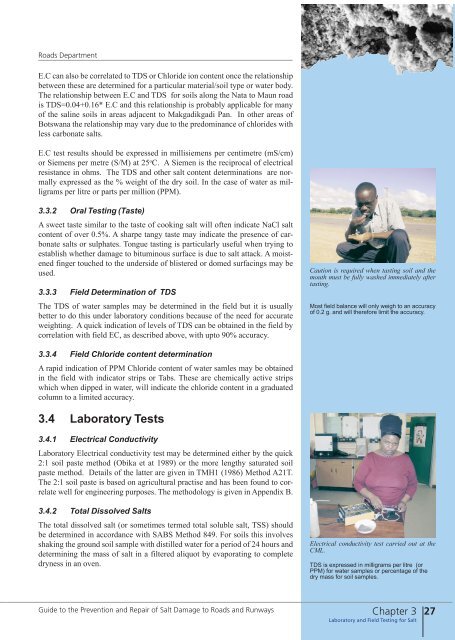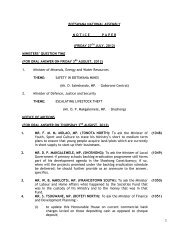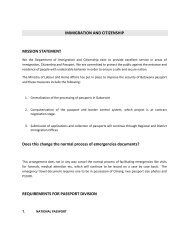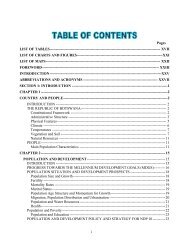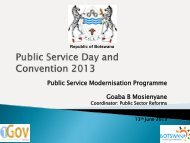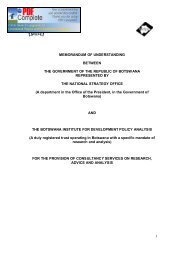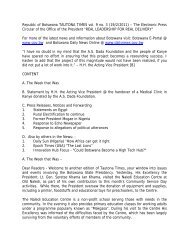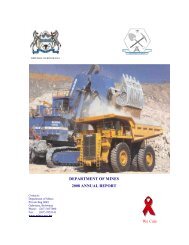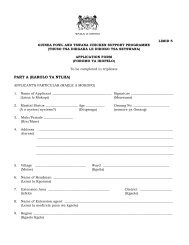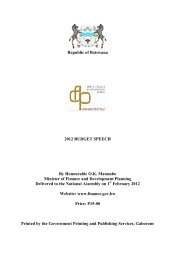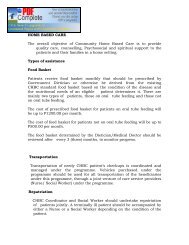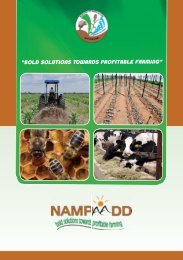Roads Department - Government of Botswana
Roads Department - Government of Botswana
Roads Department - Government of Botswana
Create successful ePaper yourself
Turn your PDF publications into a flip-book with our unique Google optimized e-Paper software.
<strong>Roads</strong> <strong>Department</strong><br />
E.C can also be correlated to TDS or Chloride ion content once the relationship<br />
between these are determined for a particular material/soil type or water body.<br />
The relationship between E.C and TDS for soils along the Nata to Maun road<br />
is TDS=0.04+0.16* E.C and this relationship is probably applicable for many<br />
<strong>of</strong> the saline soils in areas adjacent to Makgadikgadi Pan. In other areas <strong>of</strong><br />
<strong>Botswana</strong> the relationship may vary due to the predominance <strong>of</strong> chlorides with<br />
less carbonate salts.<br />
E.C test results should be expressed in millisiemens per centimetre (mS/cm)<br />
or Siemens per metre (S/M) at 25 o C. A Siemen is the reciprocal <strong>of</strong> electrical<br />
resistance in ohms. The TDS and other salt content determinations are normally<br />
expressed as the % weight <strong>of</strong> the dry soil. In the case <strong>of</strong> water as milligrams<br />
per litre or parts per million (PPM).<br />
3.3.2 Oral Testing (Taste)<br />
A sweet taste similar to the taste <strong>of</strong> cooking salt will <strong>of</strong>ten indicate NaCl salt<br />
content <strong>of</strong> over 0.5%. A sharpe tangy taste may indicate the presence <strong>of</strong> carbonate<br />
salts or sulphates. Tongue tasting is particularly useful when trying to<br />
establish whether damage to bituminous surface is due to salt attack. A moistened<br />
finger touched to the underside <strong>of</strong> blistered or domed surfacings may be<br />
used.<br />
3.3.3 Field Determination <strong>of</strong> TDS<br />
The TDS <strong>of</strong> water samples may be determined in the field but it is usually<br />
better to do this under laboratory conditions because <strong>of</strong> the need for accurate<br />
weighting. A quick indication <strong>of</strong> levels <strong>of</strong> TDS can be obtained in the field by<br />
correlation with field EC, as described above, with upto 90% accuracy.<br />
Caution is required when tasting soil and the<br />
mouth must be fully washed immediately after<br />
tasting.<br />
Most field balance will only weigh to an accuracy<br />
<strong>of</strong> 0.2 g. and will therefore limit the accuracy.<br />
3.3.4 Field Chloride content determination<br />
A rapid indication <strong>of</strong> PPM Chloride content <strong>of</strong> water samles may be obtained<br />
in the field with indicator strips or Tabs. These are chemically active strips<br />
which when dipped in water, will indicate the chloride content in a graduated<br />
column to a limited accuracy.<br />
3.4 Laboratory Tests<br />
3.4.1 Electrical Conductivity<br />
Laboratory Electrical conductivity test may be determined either by the quick<br />
2:1 soil paste method (Obika et at 1989) or the more lengthy saturated soil<br />
paste method. Details <strong>of</strong> the latter are given in TMH1 (1986) Method A21T.<br />
The 2:1 soil paste is based on agricultural practise and has been found to correlate<br />
well for engineering purposes. The methodology is given in Appendix B.<br />
3.4.2 Total Dissolved Salts<br />
The total dissolved salt (or sometimes termed total soluble salt, TSS) should<br />
be determined in accordance with SABS Method 849. For soils this involves<br />
shaking the ground soil sample with distilled water for a period <strong>of</strong> 24 hours and<br />
determining the mass <strong>of</strong> salt in a filtered aliquot by evaporating to complete<br />
dryness in an oven.<br />
Electrical conductivity test carried out at the<br />
CML.<br />
TDS is expressed in milligrams per litre (or<br />
PPM) for water samples or percentage <strong>of</strong> the<br />
dry mass for soil samples.<br />
Guide to the Prevention and Repair <strong>of</strong> Salt Damage to <strong>Roads</strong> and Runways Chapter 3<br />
Laboratory and Field Testing for Salt<br />
27


